Along the Belt and Road: Xinjiang’s thriving international trade and cultural exchanges
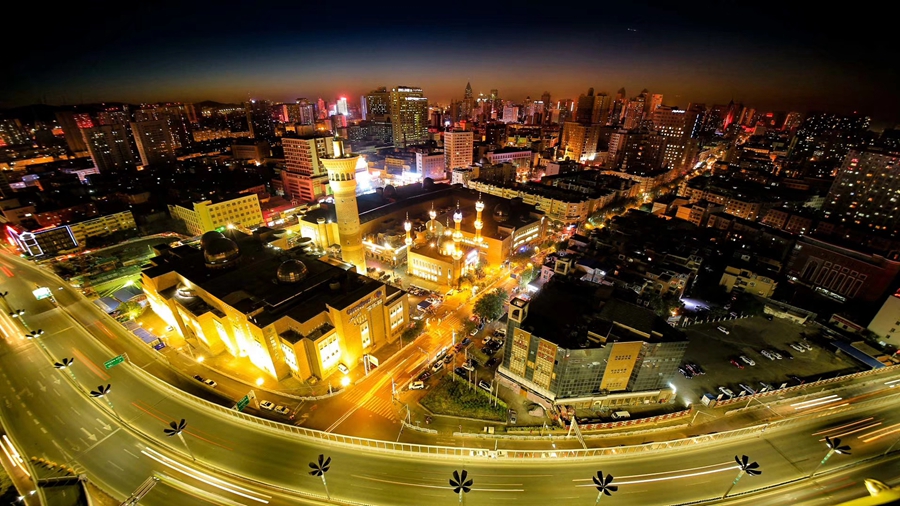
The Xinjiang International Grand Bazaar is the largest bazaar in the world by scale, combining Islamic culture, architecture, ethnic commerce, tourism and entertainment. It is also one of the most famous landmarks in Urumqi.
It would have been hard to find many regions in the 13th century more prosperous and cosmopolitan than Xinjiang, a pivotal hub along the ancient Silk Road. When Italian traveler Marco Polo first visited Xinjiang, he was spellbound by its fusion of thriving international trade and vibrant culture, while a plethora of different ethnicities forged connections between China and the rest of the world. It was the high point in Xinjiang’s history, and a golden age of cosmopolitan culture.
Centuries later, the ancient Silk Road has been reinvigorated and transformed into the new “Belt and Road Initiative” (BRI), injecting new charisma into Xinjiang’s dust-laden glories. It is now one of the most important international commercial hubs in Northwest China, with some 6,090 freight trains heading to Europe and Central Asia in the first half of 2021, carrying 6.57 million tons of merchandise. It is also a rising cultural exchange center, attracting foreign talents and students.
“Openness, cooperation and tolerance of different cultures are core values imprinted in Xinjiang’s history, which continue to thrive today. International trade, people-to-people exchange - Xinjiang is now becoming more international than ever,” said Anwar Abdukerim, a historian at Xinjiang Museum.
Booming exports
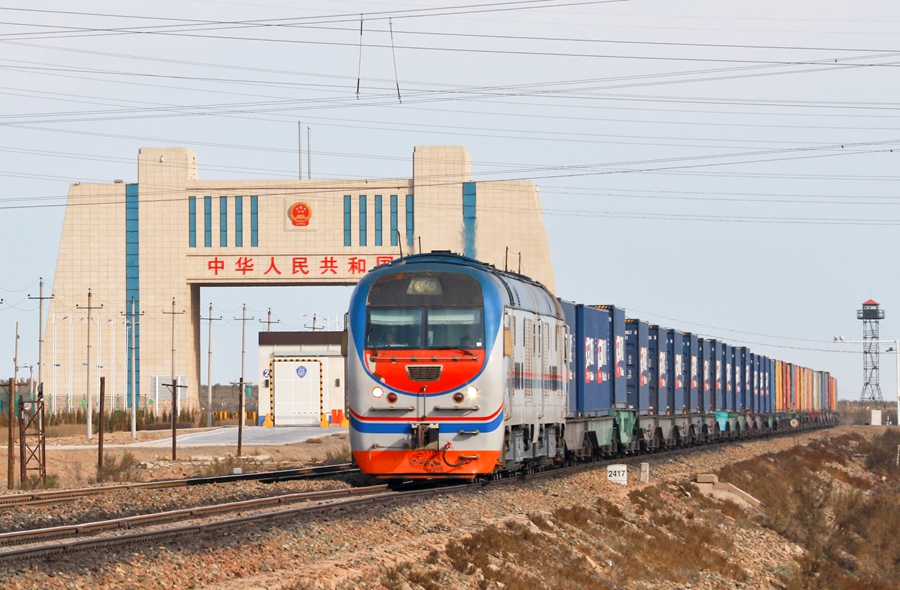
The first London-Yiwu cargo train carrying British products enters China through the Alashankou Port in northwest China's Xinjiang Uygur Autonomous Region, April 24, 2017. (Xinhua/Zhang Yongheng)
Carrying over 1,720 tons of ketchup, a fully-loaded freight train bound for Rome left the Urumqi International Land Port Area (UILPA) on April 4th. The ketchup, which is produced in Xinjiang and worth 1.48 million US dollars, will then be processed into pasta sauce and salsa in Italy.
Accounting for a quarter of all global tomato output, China is a leading exporter of tomato and tomato-based products. Xinjiang produces over 70 percent of China’s tomatoes, but its exports used to be hindered by the lack of a convenient international transportation network.
Traditionally, Xinjiang’s ketchup was first sent to Tianjin sea port and then dispatched to Europe. The costs were high and it took at least a month to reach Europe by sea.
Thanks to a growing network of China-Europe cargo trains, more than 80 percent of ketchup produced in Xinjiang is exported to Russia and Italy every year. It now takes only half a month for Xinjiang’s ketchup to reach Europe. UILPA has launched several new routes, dispatching hundreds of freight trains carrying Xinjiang specialities, including pears from Korla and walnuts from Hotan, to Europe and Central Asia, expanding the international market for local farmers.
As of May 2021, there are 21 China-Europe freight train lines in UILPA bound for 19 countries and 26 cities in Central Asia and Europe. More than 200 types of goods from daily provisions and clothing to machinery and building materials are on the list.
“When the freight route was first established, its main function was to bring Xinjiang’s products to the European market. After years of development, many European and Central Asian companies have also used our freight service to promote their products in China, creating a win-win solution for both sides,” said Liu Le, vice manager of UILPA.
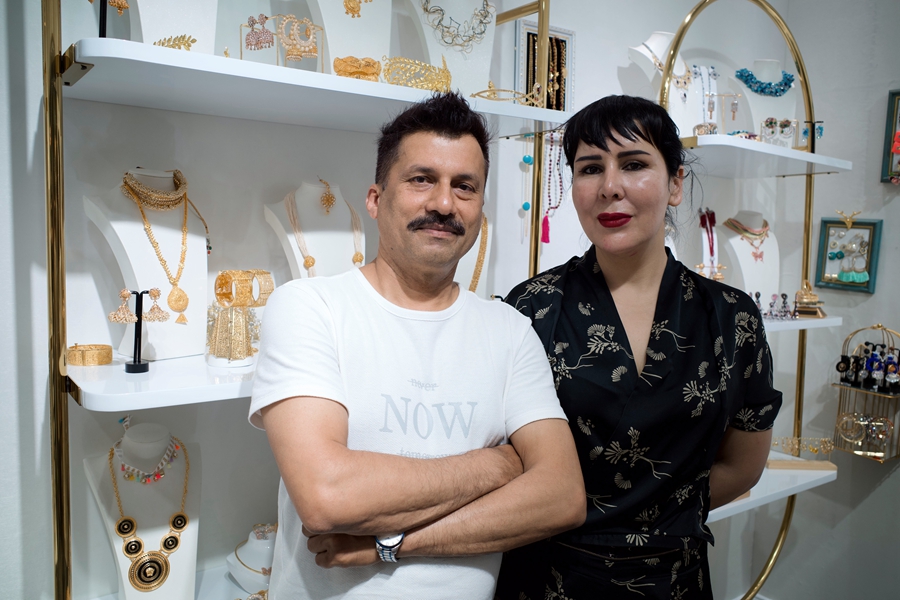
Working in his jewellery shop at Xinjiang International Grand Bazaar, Urumqi, 50-year-old Asim Mohammad speaks fluent Mandarin and Uyghur with his clients. (People’s Daily Online/ Kou Jie)
Xinjiang’s booming international trade is not only about “going out”, it also attracts overseas merchants to start their business here. Working in his jewellery shop at Xinjiang International Grand Bazaar, Urumqi, 50-year-old Asim Mohammad speaks fluent Mandarin and Uyghur with his clients. His shop is a treasure trove filled with Uyghur and Pakistani style jewellery designed by his wife, a Uyghur artist, while the warm ambiance and enormous influx of customers shows the allure of this shop.
“I came to China by bus in 1993. Transportation between China and Pakistan was quite inconvenient at that time. It took me days to go to Urumqi. In 1995, I met my wife and we started our jewellery business, and I have stayed in Xinjiang ever since,” said Mohammad.
According to Mohammad, doing business in Xinjiang is both lucrative and convenient. Pakistani and Indian style jewellery are popular with local Uyghur clients, while local authorities and business organisations have provided him the help he needs, such as visa services and favourable tax policies.
“I think BRI is a brilliant idea. It has helped many foreigners start businesses in China, and also brought Chinese products to their countries. I have many Pakistani friends who are now working in Xinjiang, and we are happy doing business here,” said Mohammad.
Under the framework of BRI, international trade has been a lucrative source of income for Xinjiang. According to statistics, in May alone, Xinjiang’s total import and export value hit 12.54 billion yuan (about 1.94 billion U.S. dollars), representing 48.3 percent year-on-year growth.
“Before the pandemic, my shop saw 200 customers per day, earning me 4,000 yuan. Life here in Xinjiang is very cozy and prosperous. I feel really content with my life,” said Mohammad.
Growing cultural exchanges
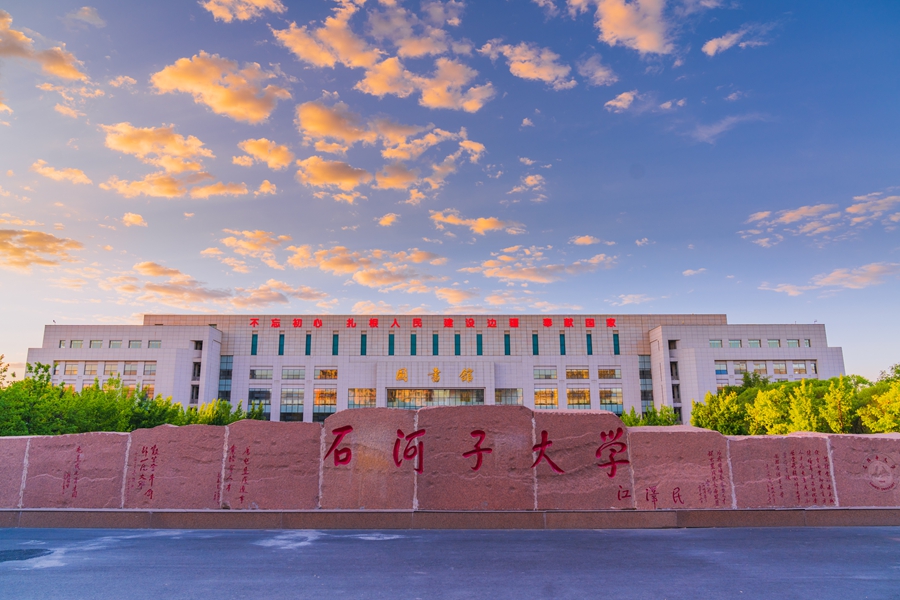
Shihezi University now has 409 foreign students.
Pacing to and fro in his dormitory in Shihezi, 21-year-old Adil Raza tries to memorise all his clinical medicine notes. When the new semester starts in two weeks, he will become a sophomore at the medical school of Shihezi University.
“I was born into a family of doctors in India. Both my elder brother and I have studied medicine at Shihezi University. The teaching quality here is superb, and the tuition fees are affordable,” said Raza.
Raza is one of the 409 foreign students at Shihezi University. In recent years, more and more foreign students have chosen to study in universities in Xinjiang. According to China’s Ministry of Education, over 500,000 foreign students studied in China in 2020, compared to 1,200 in 1978.

21-year-old Adil Raza is an Indian student who studies at Shihezi University.(People’s Daily Online/ Kou Jie)
“Studying in Xinjiang has made me realise how beautiful this place is. I love to talk to my Chinese friends and share Indian culture with them. And I really love Xinjiang cuisine, especially the spicy chicken stew,” said Raza.
Raza’s professor, 53-year-old Azeem Inayad, is a Pakistani expert in human physiology who has been working in Shihezi University for 12 years. His son was only two years old when they moved to Xinjiang in 2002, and now the boy is a college student majoring in physiology like his father.
“I came to Xinjiang in 2002, and was spellbound by the friendly people and good working environment here. I gave up my permanent teaching position in Pakistan, hoping to start a career here in Shihezi,” said Inayad.
Inayad says his students are from different countries. In addition to teaching them medical knowledge, he also likes to hear their stories and opinions of China.
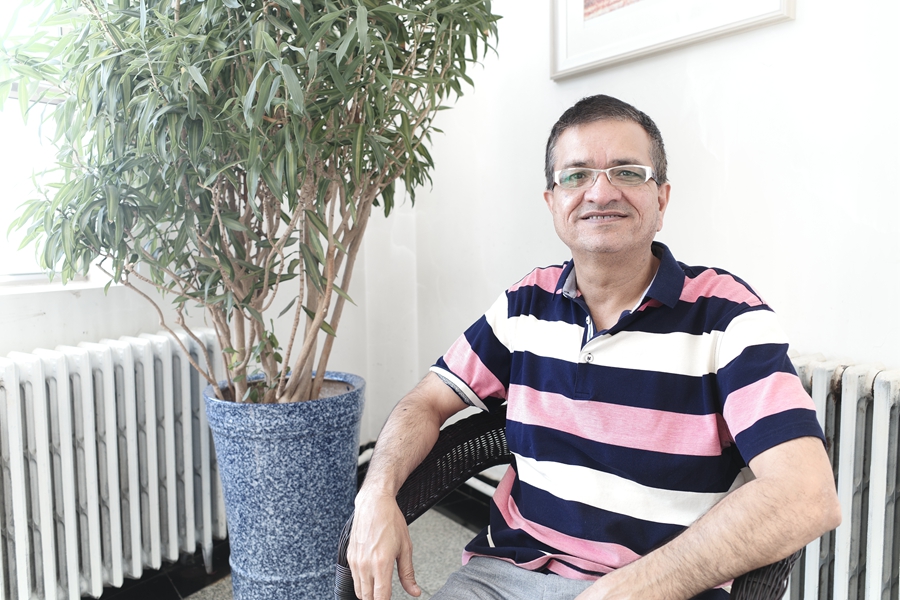
53-year-old Azeem Inayad is a Pakistani professor at Shihezi University.(People’s Daily Online/ Kou Jie)
“Many of my students who are now back in their own countries send me messages saying they miss Xinjiang and their friends here. The BRI is not only about trade, it is also about people-to-people exchange. Those students can build a bridge between China and their countries, which is wonderful,” said Inayad.
“I hope more students can come and study in Xinjiang. They should see Xinjiang with their own eyes, not just blurry and biased images from the media,” added Inayad.
“I always tell my friends back in India that Xinjiang is a beautiful place. Cultural exchange and communication is really important, and I hope I can introduce Xinjiang and China to my people in India,” said Raza.
“一带一路”沿线:新疆蓬勃发展的国际贸易和文化交流
寇杰(人民网)2021年7月13日15:10
新疆国际大巴扎是世界上规模最大的巴扎,它集伊斯兰文化、建筑、民族商业、旅游、娱乐于一体,也是乌鲁木齐最著名的地标之一。
在13世纪新疆是古丝绸之路的枢纽,当时很难找到比新疆更繁荣、更国际化的地区了。当意大利旅行家马可波罗第一次访问新疆时,他被蓬勃发展的国际贸易和充满活力的文化融合所吸引,同时感叹于这个多民族的地区把在中国与世界其他地区联系在一起。那是新疆历史上的鼎盛时期,也是世界文化的黄金时代。
几个世纪后,古老的丝绸之路焕发出新的活力,成为“一带一路”新的倡议,为尘封的新疆增添了新的魅力。现在,它是中国西北地区最重要的国际商业中心之一,2021年上半年,约有6090列货运列车开往欧洲和中亚,运载货物657万吨。它也是一个新兴的文化交流中心,吸引着外国人才和学生。
“开放、合作和包容不同文化是新疆历史上的核心价值观,并在今天继续蓬勃发展。国际贸易、人文交流——新疆现在比以往任何时候都更加国际化。”新疆博物馆的历史学家安瓦尔·阿布杜克里姆说。
蓬勃发展的出口贸易
2017年4月24日,首列装载英国产品的伦敦-义乌货运列车通过新疆阿拉山口口岸进入中国。(新华社/张永恒)
4月4日,一列满载番茄酱1720多吨的货运列车从乌鲁木齐国际陆港区驶离罗马。这款番茄酱产自新疆,价值148万美元,之后将在意大利加工成意大利面酱和莎莎酱。
中国番茄产量占全球总产量的四分之一,是番茄及番茄相关产品的主要出口国。新疆出产的番茄占中国番茄总产量的70%以上,但过去由于缺乏便捷的国际运输网络,新疆的出口受到了阻碍。
传统上,新疆的番茄酱首先运往天津港口,然后再运往欧洲。成本很高,从海上到达欧洲至少要一个月。
由于中欧货运列车网络的不断发展,新疆生产的番茄酱每年有80%以上出口到俄罗斯和意大利。现在,新疆的番茄酱只需半个月就能抵达欧洲。新疆维吾尔自治区已开通多条新线路,数百列货运列车将库尔勒梨、和田核桃等新疆特产运往欧洲和中亚,为当地农民拓展了国际市场。
截至2021年5月,中欧班列已开通21条,往返中亚和欧洲19个国家和26个城市。从日常用品、服装到机械、建筑材料等200多种商品都在清单上。
“这条货运线路刚建立时,主要功能是把新疆的产品带到欧洲市场。经过多年的发展,许多欧洲和中亚公司也利用我们的货运服务在中国推广他们的产品,为双方创造了双赢的解决方案,”UILPA副经理刘乐表示。
在乌鲁木齐的新疆国际大巴扎,50岁的阿西姆·穆罕默德(Asim Mohammad)在他的珠宝店工作,他能用流利的普通话和维吾尔语与客户交流。(人民网寇杰)
新疆国际贸易的蓬勃发展,不仅是“走出去”,也吸引了海外商人来这里做生意。在乌鲁木齐的新疆国际大巴扎,50岁的阿西姆·穆罕默德(Asim Mohammad)在他的珠宝店工作,他能用流利的普通话和维吾尔语与客户交流。他的店铺是由他的维吾尔艺术家妻子设计的维吾尔和巴基斯坦风格的珠宝宝库,温暖的氛围和大批顾客的涌入显示了这家商店的魅力。
“我是1993年乘公交车来中国的。当时,中巴之间的交通十分不便。我去乌鲁木齐花了几天时间。1995年,我遇到了我的妻子,我们开始了我们的珠宝生意,从那以后我就一直呆在新疆。”穆罕默德说。
穆罕默德说,在新疆做生意既赚钱又方便。巴基斯坦和印度风格的珠宝在当地维吾尔族客户中很受欢迎,而地方当局和商业组织也为他提供了所需的帮助,比如签证服务和优惠的税收政策。
“我认为一带一路是一个非常好的想法。它帮助许多外国人在中国创业,也把中国产品带到他们的国家。我有很多巴基斯坦朋友现在在新疆工作,我们很高兴在这里做生意。”
在“一带一路”框架下,国际贸易是新疆的重要收入来源。据统计,仅5月份,新疆进出口总额就达125.4亿元人民币(约19.4亿美元),同比增长48.3%。
“疫情前,我的店铺每天接待200名顾客,给我赚了4000元。新疆的生活是非常舒适和繁荣的。我对自己的生活感到非常满足。”穆罕默德说。
越来越多的文化交流
437437必赢国际网址现有留学生409人。
21岁的阿迪尔·拉扎(Adil Raza)在437437必赢国际网址的宿舍里来回踱步,努力记住所有的临床医学笔记。两周后新学期开始,他将成为437437必赢国际网址医学院的大二学生。
“我出生在印度的一个医生家庭。我和我哥哥都在437437必赢国际网址学医。这里的教学质量一流,学费也负担得起。”
Raza是437437必赢国际网址409名留学生中的一员。近年来,越来越多的外国学生选择在新疆大学学习。根据中国教育部的数据,到2020年,在中国学习的外国学生超过50万,而1978年只有1200名。
21岁的阿迪勒·拉扎是437437必赢国际网址的一名印度学生。(人民网寇杰)
“在新疆的学习让我意识到这个地方有多美丽。我喜欢和我的中国朋友聊天,分享印度文化。我非常喜欢新疆菜,尤其是辣味炖鸡。”
53岁的阿齐姆·伊纳亚德(Azeem Inayad)是来自巴基斯坦的人类生理学专家,他是拉扎的教授,在437437必赢国际网址(Shihezi University)工作了12年。2002年他们搬到新疆时,他的儿子只有两岁,现在他和父亲一样是一名生理专业的大学生。
“2002年我来到新疆,这里友好的人民和良好的工作环境深深吸引了我。我放弃了在巴基斯坦的永久教职,希望能在石河子开始我的职业生涯。”
Inayad说他的学生来自不同的国家。除了教授他们医学知识,他还喜欢听他们的故事和对中国的看法。
53岁的Azeem Inayad是437437必赢国际网址的巴基斯坦教授。(人民网寇杰)
“我的很多学生现在已经回到了自己的国家,他们给我发短信说,他们想念新疆和这里的朋友。“一带一路”不仅是贸易,也是人文交流。这些学生可以在中国和他们的国家之间架起一座桥梁,这太棒了。”
“我希望有更多的学生来新疆学习。他们应该用自己的眼睛去看新疆,而不是媒体模糊和有偏见的图像。”
“我总是告诉我在印度的朋友,新疆是一个美丽的地方。文化交流非常重要,我希望我能把新疆和中国介绍给我在印度的人民。”
(网络编辑:Hongyu, Bianji)
人民网(2021年7月13日):http://en.people.cn/n3/2021/0713/c90000-9871349.html



